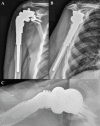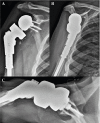Traumatic Glenosphere Dissociation Following Reverse Total Shoulder Endoprosthetic Reconstruction for Proximal Humerus Periosteal Chondrosarcoma: A Case Report
- PMID: 33708714
- PMCID: PMC7933640
- DOI: 10.13107/jocr.2020.v10.i08.1862
Traumatic Glenosphere Dissociation Following Reverse Total Shoulder Endoprosthetic Reconstruction for Proximal Humerus Periosteal Chondrosarcoma: A Case Report
Abstract
Introduction: Reverse total shoulder endoprosthetic reconstruction after margin-negative tumor resection of the proximal humerus is becoming more conventional in orthopeadic oncology practices. Mid-term survival and functional outcomes have been satisfactory. This case report corroborates with current literature and further describes a rare traumatic complication.
Case presentation: We report a case of a 70-year-old male with periosteal chondrosarcoma of the proximal humerus who underwent margin-negative resection and reverse total shoulder endoprosthetic reconstruction that was complicated by glenosphere dissociation sustained from falling onto a hyperflexed arm. Successful revision arthroplasty was performed.
Conclusion: Enhancing glenohumeral joint stability after wide resection of the proximal humerus is important to address rotator cuff insufficiency. The greater levering effect of a longer humeral prosthesis used to increase soft tissue tension may also increase the risk of glenosphere dissociation secondary to trauma. Proper soft-tissue tensioning and surgical technique are critical.
Keywords: Glenosphere dissociation; periosteal chondrosarcoma; reverse total shoulder endoprosthetic reconstruction.
Copyright: © Indian Orthopaedic Research Group.
Conflict of interest statement
Conflict of Interest: Nil
Figures







References
-
- Gelderblom H, Hogendoorn PC, Dijkstra SD, van Rijswijk CS, Krol AD, Taminiau AH, et al. The clinical approach towards chondrosarcoma. Oncologist. 2008;13:320–9. - PubMed
-
- Cleven AH, Zwartkruis E, Hogendoorn PC, Kroon HM, Briaire-de Bruijn I, Bovée JV. Periosteal chondrosarcoma:A histopathological and molecular analysis of a rare chondrosarcoma subtype. Histopathology. 2015;67:483–90. - PubMed
-
- Goedhart LM, Ploegmakers JJ, Kroon HM, Zwartkruis EC, Jutte PC. The presentation treatment and outcome of periosteal chondrosarcoma in the Netherlands. Bone Joint J. 2014;96:823–8. - PubMed
-
- Nota S, Teunis T, Kortlever J, Ferrone M, Ready J, Gebhardt M, et al. Functional outcomes and complications after oncologic reconstruction of the proximal humerus. J Am Acad Orthop Surg. 2018;26:403–9. - PubMed
Publication types
LinkOut - more resources
Full Text Sources
